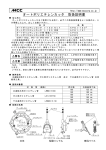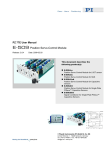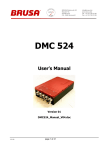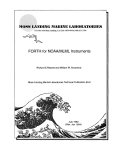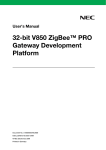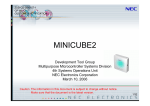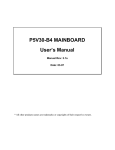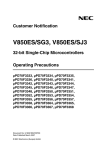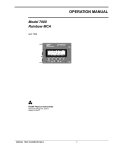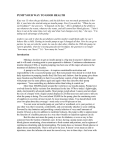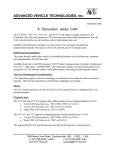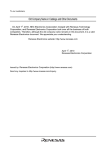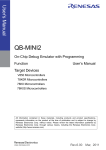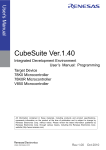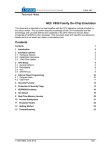Download User`s Manual
Transcript
CEB-V850ES/FJ3·SJ3 EVALUATION BOARD HARDWARE USER’S MANUAL Date Published April 2007 (The 1st edition) COSMO Co., Ltd. Control No. CCEB-HUMFJ3SJ3_010E CEB-V850ES/FJ3·SJ3 Evaluation Board HardwareUser’s Manual Cautions • The information in this document is subject to change without notice. Before using this document, please confirm that this is the latest version. • No part of this document may be copied or reproduced in any form or by any means without the prior written consent of COSMO Co., Ltd. • COSMO Co., Ltd. does not assume any liability for infringement of patents, copyrights or other intellectual property rights of third parties by or arising from use of device described herein or any other liability arising from use of such device. No license, either express, implied or otherwise, is granted under any patents, copyrights or other intellectual property rights of COSMO Co., Ltd. Descriptions of circuits, and other related information in this document are provided for illustrative purposes in semiconductor product operation and application examples. The incorporation of these circuits, and information in the design of the customer’s equipment shall be done under the full responsibility of the customer. COSMO Co., Ltd. assumes no responsibility for any losses incurred by the customer or third parties arising from the use of these circuits, and information. The information in this document is current as of 2007. The information is subject to change without notice. Trademarks CEB-V850ES/FJ3·SJ3 is a trademark of COSMO Co., Ltd. Other company names and product names provide in this document are either registered trademarks or trademarks of respective companies. CEB-V850ES/FJ3·SJ3 Evaluation Board HardwareUser’s Manual CONTENTS 1. Overview ..................................................................................................................................................... 4 2. Evaluation CPU Board CEB-V850ES/FJ3·SJ3............................................................................................ 4 3. Document .................................................................................................................................................... 4 4.1 Hardware Specifications .............................................................................................................................. 5 4.2 Block Diagram ............................................................................................................................................. 6 4.3 Configuration ............................................................................................................................................... 7 4.3.1 Power supply........................................................................................................................................... 8 4.3.2 CAN-I/F ................................................................................................................................................. 10 4.3.3 LIN-I/F ................................................................................................................................................... 14 4.3.4 Expansion connectors (J5, J6) .............................................................................................................. 17 4.3.5 7-segment LED (LED1) ......................................................................................................................... 18 4.3.6 8-bit DIP SW (SW1) .............................................................................................................................. 18 4.3.7 RESET .................................................................................................................................................. 19 4.3.8 INTP0 SW (SW2) .................................................................................................................................. 20 4.3.9 NMI SW (SW3)...................................................................................................................................... 20 4.3.10 CLOCK............................................................................................................................................... 21 4.3.11 USB.................................................................................................................................................... 22 4.3.12 Evaluation environment...................................................................................................................... 24 4.3.13 The connector for MINICUBE (CN6) .................................................................................................. 27 4.3.14 The connector for FL-PR4, MINICUBE2 (CN5) .................................................................................. 28 4.3.15 The connector for CPU I/O pins check ............................................................................................... 29 4.4 Memory map ............................................................................................................................................. 31 4.5 Notes at the time of user circuitry .............................................................................................................. 33 4.5.1 Consumption current ............................................................................................................................. 33 4.5.2 I/O signals ............................................................................................................................................. 33 4.6 A jumper setup at the time of shipment ..................................................................................................... 34 5. CAN expansion board ............................................................................................................................... 35 5.1 Specifications ........................................................................................................................................ 35 5.2 Block diagram ....................................................................................................................................... 35 5.3 Board size ............................................................................................................................................. 36 5.4 External connectors............................................................................................................................... 37 5.5 Evaluation board mating........................................................................................................................ 38 CEB-V850ES/FJ3·SJ3 Evaluation Board HardwareUser’s Manual 1. Overview This manual prescribes a CEB-V850ES/FJ3 evaluation board and a CEB-V850ES/SJ3 evaluation board. CEB-V850ES/FJ3·SJ3 is called below about two kinds of evaluation boards. 2. Evaluation CPU Board CEB-V850ES/FJ3·SJ3 The CEB-V850ES/FJ3 features an NEC Electronics-made 32-bit single-chip microcontroller V850ES/FJ3, USB interface, 7-segment LED, CAN interface, LIN interface, N-wire connector, etc. The CEB-V850ES/SJ3 features an NEC Electronics-made 32-bit single-chip microcontroller V850ES/SJ3. Other devices are the same as CEB-V850-ES/FJ3. This board is designed so that the CPU pins can be provided outside the board by connecting an optional add-in board. The MINICUBE or the MINICUBE2 can be used as debugging environment. The FL-PR4 (FlashPro4) (hereafter, FL-PR4) made by Naito Densei Machida Mfg. Co., Ltd. is required for writing programs. *Besides FL-PR4, FP-LITE and MINICUBE2 can be written in. The MINICUBE, the MINICUBE2, the FL-PR4 are not included with this evaluation kit. 3. Document The following documents are included as PDF files. CEB-V850ES/FJ3·SJ3 Evaluation Board Hardware User's Manual CEB-V850ES/FJ3 Evaluation Board Circuit Diagrams CEB-V850ES/FJ3 Evaluation Board Parts List CEB-V850ES/SJ3 Evaluation Board Circuit Diagrams CEB-V850ES/SJ3 Evaluation Board Parts List V850ES/FJ3 Hardware Preliminary User's Manual V850ES/SJ3 Hardware Preliminary User's Manual 4 CEB-V850ES/FJ3·SJ3 Evaluation Board HardwareUser’s Manual 4.1 Hardware Specifications The specifications of the CEB-V850ES/FJ3·SJ3 Starter’s Kit Evaluation Board are shown below. • CPU V850ES/FJ3 × 1 (or V850ES/SJ3) ·V850ES/FJ3 Operating CLK direct mode: 6 MHz, PLL mode: 48 MHz Oscillator (MAIN: 6 MHz , SUB: 32.768 KHz ) ·V850ES/SJ3 Operating CLK direct mode: 4 MHz, PLL mode: 32 MHz Oscillator (MAIN: 4 MHz , SUB: 32.768 KHz ) * The crystal for MAIN clocks is socket-mounted. • Check pin A through hole for each signal line check is around CPU. ( Two rows of half pitch) • External connectors Expansion connector (30-pin 2.54 pitch) × 2 Flash PRO4 connector (16-pin) × 1 MINICUBE connector (26-pin) × 1 CAN-I/F connector (9-pin D-SUB [female] ) × 2 LIN-I/F connector (3-pin) × 2 • SW PUSH SW × 3 (RESET, NMI, INT0 ) DIP SW (8-bit) × 1 • Jumpers Development environment setting(FL-PR4·MINICUBE/MINICUBE2) UART setting (USB/FL-PR4·MINICUBE2) CAN termination resistance setting LIN-master/slave switching • LED Power LED (+5 V ): Green, 7-segment LED × 1 • Check pin +12 V, +5 V, +3.3 V, GND • Power supply AC adapter (DC+12 V) input With regulator IC, +5 V(FJ3) , +3.3V(SJ3) output 5 CEB-V850ES/FJ3·SJ3 Evaluation Board HardwareUser’s Manual 4.2 Block Diagram Whole block diagram V 850ES / FJ 3 starter kit whole block diagram MINICUBE FL-PR4/MINICUBE2 Expansion J5 LIN1 + 12 V DRV LIN 0 DRV Expansion J 6 DRV CAN1 C _ POW FJ 3 USB / UART USB CAN 0 C _ POW DRV DIPSW8 bit RESET NMI 7 seg8 bit INTP0 Power supply + 12V +5 V C - POW RSJ +12V IN 12 / 5 reg 5 / 3. 3 reg RFJ VBUS USB miniB Max 500mA Figure 4.2 The above figure is the case where V850ES/FJ3 is mounted. In this case, CPU power supply voltage is set to +5V. Moreover, when V850ES/SJ3 is mounted, CPU power supply voltage is set to +3.3V.* * Since a voltage setup is set up at the time of shipment, especially a visitor does not need to be conscious of it. 6 CEB-V850ES/FJ3·SJ3 Evaluation Board HardwareUser’s Manual 4.3 Configuration The following figure shows the physical placement and the outside of the major components on the CEB-V850ES/FJ3·SJ3 evaluation CPU board. The various components are described below. Figure 4.3 7 CEB-V850ES/FJ3·SJ3 Evaluation Board HardwareUser’s Manual 4.3.1 Power supply (1) Power supply part Although premised fundamental on use in +12V input from the attached AC/DC adaptor, it is possible to also make it operate by the power supply supply from a USB port. Notes: As for the USB port, power supply supply capability is restricted to 500mA by specification. When you operate this board in a USB port, please use consumption current by 500mA or less. moreover, since +5V are supplied from a USB port, A LIN-I/F function cannot be used. A block diagram is shown below. Power Supply +12 V +5 V C - POW RSJ +12 V IN 12 / 5 reg 5 / 3.3 reg RFJ VBUS USB miniB Max 500 mA + 12 V LIN - 0 LIN - 1 + 5V Peripheral IO device Expansion connectors C -POW CPU CPU Peripheral ( Pull -up resistance ) Figure 4.3.1 (1) 8 CEB-V850ES/FJ3·SJ3 Evaluation Board HardwareUser’s Manual (2) Power supply connector (CN8) Please use DC jack side of an attached AC adaptor for a power supply connector (CN8), connecting. The power supply to supply is as follows. AC adaptor : NP12-US1210 (Akizuki Denshi Corp) Input voltage range : 100-240 V 50/60 Hz Output voltage : DC12 V Current : 1 A max Suitable connector : Type A (φ5.5) Polarity : +12V GND Figure 4.3.1 (2) 9 GND +12V CEB-V850ES/FJ3·SJ3 Evaluation Board HardwareUser’s Manual 4.3.2 CAN-I/F (1) CAN-I/F overview Two CAN interfaces are mounted as standard. A block diagram is shown below. Open setting jumper JPX2,4 CAN transceiver ( TJA 1050 ) CTXDn TXD CAN_H CRXDn RXD CAN_L Open setting jumper JPX1,3 Common mode filter Terminator change jumper JP1,2 D-SUB 9 pin [ female] RS 5 9 4 8 3 7 2 6 1 P*** V850ES/FJ3·SJ3 Figure 4.3.2 (1) 10 CEB-V850ES/FJ3·SJ3 Evaluation Board HardwareUser’s Manual (2) CAN-I/F connector (CN1, CN2) CAN0 is assigned to CN1 and CAN1 is assigned to CN2, respectively. Since the connector on a substrate mounts Dsub9 pin (female), the connector by the side of a cable should use Dsub9 pin (male) at the time of cable creation. Pin distribution table is shown below. Pin№ 1 2 3 4 5 6 7 8 9 CAN I/F connector pin distribution table CN1(CAN0) CN2(CAN1) N.C. N.C. CAN_L1 CAN_L2 GND GND N.C. N.C. Coupling with capacitor and fed to GND. Coupling with capacitor and fed to GND. N.C. N.C. CAN_H1 CAN_H2 N.C. N.C. N.C. N.C. Table 4.3.2 (2) Connector part number : XM3B-0922-112 (OMRON Corp.) 11 CEB-V850ES/FJ3·SJ3 Evaluation Board HardwareUser’s Manual (3) CAN transceiver TJA1050T (made by Philips Corp.) are mounted in this board as a CAN transceiver. Refer to the applicable data sheet for the details of a device. Connection of CPU and a CAN transceiver is shown below. CAN0 connection CPU CTXD0(P33) CRXD0(P34) PCM4 TJA1050T TXD RXD VREF CAN_H,CAN_L RS VCC,GND Signal Name Transmitting data Receiving data VREF CAN RS Power supply(+5Vsupply) Table 4.3.2 (3)-1 CAN1 connection CPU CTXD1(P36) CRXD1(P37) PCM5 TJA1050T TXD RXD VREF CAN_H,CAN_L RS VCC,GND Signal Name Transmitting data Receiving data VREF CAN RS Power supply(+5Vsupply) Table 4.3.2 (3)-2 (4) CAN signal terminus setup A CAN signal terminus value is set up by JP1 and JP2. JP1 corresponds to CAN0 and JP2 correspond to CAN1, respectively. JP1,2 4 2 3 1 Setup open 1-2 short circuit 1-2,3-4 short circuit others Terminator value (common to JP1 and JP2) Infinite (default) 120Ω 60Ω Prohibition of a setup Table 4.3.2 (4) 12 CEB-V850ES/FJ3·SJ3 Evaluation Board HardwareUser’s Manual (5) About JPX1-JPX4 Although the pattern connects between 1-2 and between 3-4 of JPX1-JPX4, a signal is separable by cutting the pattern on the back side (soldering side) of each jumper. As standard, the following jumper is un-mounting. JPX1,3 JPX2,4 4 2 4 2 3 1 3 1 The installation part of each jumper is shown below. JPX JPX1 JPX2 JPX3 JPX4 Function CAN0 ( Between CAN transceiver - 0 CAN connector ) CAN0 ( Between CPU - CAN transceiver ) CAN1 ( Between CAN transceiver - CAN connector ) CAN1 ( Between CPU - CAN transceiver ) Table 4.3.2 (5) 13 CEB-V850ES/FJ3·SJ3 Evaluation Board HardwareUser’s Manual 4.3.3 LIN-I/F (1) LIN-I/F outlline Two LIN interfaces are mounted as standard. A block diagram is shown below. + 12V LIN transceiver ( TJA1020) Open setting jumper JPX5 , 8 BAT TXDA* TXD RXDA* RXD NWAKE INH Open setting jumper JPX 7 , 9 Open setting jumper JPX6 , 10 1 NSLP + 12 V Master / Slave Change jumper JP4 , 6 Cmaster V 850ES/FJ 3·SJ 3 Figure 4.3.3 (1) (2) LINE-I/F connector (CN3, CN4) LIN0 is assigned to CN3 and LIN1 is assigned to CN4, respectively. Connector pin distribution table is shown below. Pin№ 3 pin connector LIN P*** 1 2 3 Master / Slave Change jumper JP3 , 5 LIN I/F connector pin description CN3(LIN0) CN4(LIN1) LIN_Bus LIN_Bus +12V +12V GND GND Table 4.3.3 (2) Connector part number : IL-SP-S3FP2(J.S.T. Mfg Co.Ltd.) 14 2 3 Cslave CEB-V850ES/FJ3·SJ3 Evaluation Board HardwareUser’s Manual (3) LIN transceiver TJA1020T (made by Philips Corp.) are mounted in this board as a LIN transceiver. Refer to the applicable data sheet for the details of a device. Connection of CPU and a LIN transceiver is shown below. LIN0 CPU RXDD2(P39) P63 (pullup) TXDD2(P38) TJA1020T RXD NSLP NWAKE TXD LIN INH BAT,GND (JP3) Signal name Reception SLEEP MODE Transmission LIN MASTER/SLAVE Powersupply(+12V supply) Table 4.3.3 (3)-1 LIN1 CPU RXDD3(P80) P64 (pullup) TXDD3(P81) TJA1020T RXD NSLP NWAKE TXD LIN INH BAT,GND (JP5) Signal name Reception SLEEP MODE Transmission LIN MASTER/SLAVE Power supply(+12V supply) Table 4.3.3 (3)-2 (4) LIN MASTER/SLAVE setting A jumper is set up by the mode of LIN of operation. JP3−6 1 2 3 ・LIN0 MASTER/SLAVE Jumper MASTER setting JP3 2-3 short circuit (default) JP4 1-2 short circuit (default) SLAVE setting 1-2 short circuit 2-3 short circuit Table 4.3.3 (4)-1 ・LIN1 MASTER/SLAVE Jumper MASTER setting JP5 2-3 short circuit JP6 1-2 short circuit SLAVE setting 1-2 short circuit (default) 2-3 short circuit (default) Table 4.3.3 (4)-2 15 CEB-V850ES/FJ3·SJ3 Evaluation Board HardwareUser’s Manual (5) About JPX5-JPX10 Although the pattern connects between 1-2 and between 3-4 of JPX5-JPX8, and between 1-2 of JPX6, JPX9, JPX10, a signal is separable by cutting the pattern on the back side (soldering side) of each jumper. As standard, the following jumper is un-mounting. JPX5,8 JPX6,7,9,10 4 2 1 2 3 1 The installation part of each jumper is shown below. JPX JPX5 JPX6 JPX7 JPX8 JPX9 JPX10 Function LIN0 ( Between CPU - LIN transceiver ) LIN0 ( Between CPU – LIN transceiver NSLP ) LIN0 ( Between LIN transceiver – LIN connector ) LIN1 ( Between CPU – LIN transceiver ) LIN1 ( Between CPU – LIN transceiver NSLP ) LIN1 ( Between LIN transceiver – LIN connector ) Table 4.3.3 (5) 16 CEB-V850ES/FJ3·SJ3 Evaluation Board HardwareUser’s Manual 4.3.4 Expansion connectors (J5, J6) It is the connector used in case an optional CAN add-in board etc. is connected. As standard, it is not mounted. Expansion connectors table J5 Pin № J6 Pin № Function used on a Board Signal name Function used on a Board Signal name 1 P00 8bit DIP-SW 1 P98/SOB1(A8) - 2 P10/INTP9 - 2 P912/_SCKB2(A12) - 3 P01 8bit DIP-SW 3 P99/_SCKB1(A9) - 4 P11/INTP10 - 4 P913/INTP4(A13) - 5 P03/INTP0 Push-SW(INTP0) 5 P910/SIB2(A10) - 6 P32/ASCKA0 8bit DIP-SW 6 P914/INTP5(A14) - 7 P04/INTP1 - 7 P911/SOB2(A11) - 8 P35 8bit DIP-SW 8 P915/INTP6(A15) - 9 P06/INTP3 - 9 PCS0/_CS0 - 10 P41/SOB0 Flash PRO4 10 PCM0/_WAIT 11 P40/SIB0 Flash PRO4 11 PCS1/_CS1 - 12 P42/_SCKB0 Flash PRO4 12 P36(IETX0) - 13 P50/KR0 8bit DIP-SW 13 PCS2/_CS2 - 14 P53/KR3/DDO N-Wire 14 P37(IERX0) - 15 P51/KR1 8bit DIP-SW 15 PCS3/_CS3 - 16 P54/KR4/DCK N-Wire 16 PCT5 8bit DIP-SW 17 P52/KR2/DDI N-Wire 17 P73/ANI3 - 18 P55/KR5/DMS N-Wire 18 PCT7 8bit DIP-SW 19 P90/TXDA1(A0) - 19 P72/ANI2 - 20 P95(A5) - 20 P60/INTP11 Expansion CAN(CAN2)RS 21 P91/RXDA1(A1) - 21 P61/INTP12 Expansion CAN(CAN3)RS 22 P96(A6) - 22 P70/ANI0 23 P92(A2) - 23 P71/ANI1 - 24 P97/SIB1(A7) - 24 P65/CTXD2 Expansion CAN(CAN2)TXD 25 P93(A3) - 25 P66/CRXD2 Expansion CAN(CAN2)RXD 26 CPOW 26 +5V 27 P94(A4) - 27 P67/CTXD3 Expansion CAN(CAN3)TXD 28 _RESET Push-SW(RESET) 28 P68/CRXD3 Expansion CAN(CAN3)RXD 29 GND 29 +12V - 30 GND 30 GND Table 4.3.4 The pull-up of each signal is carried out by resistance 47kΩ. CPOW=CPU power supply FJ3:+5V, SJ3:+3.3V 17 CEB-V850ES/FJ3·SJ3 Evaluation Board HardwareUser’s Manual 4.3.5 7-segment LED (LED1) The seven-segment LED is mounted on a board. The LED can be statically switched on the light or put out from the port of CPU. In case you make each segment turn on, please set a corresponding port as "0." a f b g e c DP d a. PCD 0 b. PCD1 c. PCD2 d. PCD3 e. PCS 4 f . PCS 5 g. PCS 6 DP. PCS7 Figure 4.3.5 Segment a b c d e f g D.P. Correspondence port PCD0 PCD1 PCD2 PCD3 PCS4 PCS5 PCS6 PCS7 Light/Extinguish 0/1 0/1 0/1 0/1 0/1 0/1 0/1 0/1 default 1(pullup) 1(pullup) 1(pullup) 1(pullup) 1(pullup) 1(pullup) 1(pullup) 1(pullup) Table 4.3.5 4.3.6 8-bit DIP SW (SW1) 8-bit DIP SW is mounted on a board. ON/OFF of DIP SW can be checked in a CPU port. If DIP SW is turned "ON", a port will be set to "0", and a port will be set to "1" if it turns "OFF." bit Port DIP-SW1 DIP-SW2 DIP-SW3 DIP-SW4 DIP-SW5 DIP-SW6 DIP-SW7 DIP-SW8 P50 P51 PCT5 PCT7 P32 P35 P00 P01 Table 4.3.6 18 CEB-V850ES/FJ3·SJ3 Evaluation Board HardwareUser’s Manual 4.3.7 RESET (1) RESET overview When the time of power on or SW4 are pushed, reset starts a board. It is a RESET signal at the MINICUBE or FL-PR4 use and MINICUBE2 use time, and composition differs. A reset signal block diagram is shown below. FJ3/SJ3 MINICUBE·FL-PR4/MINICUBE2 connection (Reset signal block diagram) The flow of a reset signal MINICUBE2 V850FJ3/SJ3 MINICUBE FL-PR4/MINICUBE2 connector FL-PR4 1 GND 2 /RESout 3 SI/RXD 4 VDD 5 SO / TXD FLMD0 6 VPP FLMD1 P30/TXD0 P31/RXD0 C-POW 7 SCK 8 H/S 9 CLK 10 VDE 11 VDD2 12 FLMD1 DMS 13 RFU-1 DDO 14 FLMD0 /DRST 15 (/ RESin) 16 NC MINICUBE2 /RESin Resistance for logic stable P62 C-POW A B DDI Y _ A/B DCK A B Y _ A/B /RESET C-POW MINICUBE C-POW A7 DDI A8 DCK A9 DMS A10 DDO A11 / DRST A12 /RESET A13 FLMD0 MNICUBE,FL-PR4, and MINICUBE2 are promised on exclusion use, respectively. (/RESET signal is communalized) Figure 4.3.7 19 Connection apparatus Short pin Select MINICUBE2 2-3 A MINICUBE 1-2 B FL-PR4 1-2 B Nothing 1-2 B CEB-V850ES/FJ3·SJ3 Evaluation Board HardwareUser’s Manual (2)RESET signal setting (JP7) A setup of a RESET signal changes with apparatus connected. JP7 performs a setup. JP7 1 2 3 JP7 Function 1-2 short circuit Normal use, During connecting FL-PR4, During connecting MINICUBE (default ) 2-3 short circuit During connecting MINICUBE2 Table 4.3.7 (2) In case FL-PR4 or MINICUBE are used, a JP7 short pin is set to the "1-2" side, and it is set as the course of dashed-and-dotted line (FL-PR4) and a dotted line (MINICUBE). (Refer to Figure 4.3.7) In case MINICUBE2 is used, a JP7 short pin is set to the "2-3" side, and it is set as the course of a solid line (MINICUBE2). Please use a JP7 short pin for the "1-2" side at the time of real operation, setting it up (when you do not use a debugger). (3)RESET SW (SW4) If SW4 is pushed, CPU and an evaluation board will be in a reset state. 4.3.8 INTP0 SW (SW2) SW2 on a board is connected to P03-/INTP0 port. A push on SW2 inputs "0" into P03-/INTP0 port. 4.3.9 NMI SW (SW3) SW3 on a board is connected to P02-/NMI port. A push on SW3 inputs "0" into P02-NMI port. 20 CEB-V850ES/FJ3·SJ3 Evaluation Board HardwareUser’s Manual 4.3.10 CLOCK (1) Main Clock The crystal oscillator is connected to X1 and X2 terminals of CPU. Oscillation frequency is 6MHz in FJ3, and it is 4MHz in SJ3. Since the socket is mounted, a crystal oscillator is exchangeable if needed. Please purchase a HC49 U/S type crystal oscillator. Since it operates by the CPU internal clock by the default, in case an external clock is used, an inside register setup of CPU is changed. Please refer to an applicable CPU user’s manual for details. (2)Sub Clock The crystal oscillator is connected to XT1 and XT2 terminals of CPU. Oscillation frequency is 32.768kHz. Since it is soldered directly, crystal is unexchangeable. 21 CEB-V850ES/FJ3·SJ3 Evaluation Board HardwareUser’s Manual 4.3.11 USB (1) USB overview USB connection is made using the UART interface of CPU. USB-UART interface device FT232R is mounted and USB is changed into UART. The USB section block diagram is shown below. FJ3/SJ3 USB connection C-POW +5V V850FJ3/SJ3 FT232R VBUS 1kΩ miniB P30/TXD0 RXD VCC VBUS P31/RXD0 TXD USBN USBN /RTS USBP USBP C-POW /CTS GND VCCIO FP4-TXD FP4-RXD C-POW VBUS P69 /VBUSEN Supplement : Power supply +12V +12V IN +5V 12/5 reg C-POW 5/3.3 reg RSJ RFJ VBUS USB miniB Max500mA Figure 4.3.11 22 CEB-V850ES/FJ3·SJ3 Evaluation Board HardwareUser’s Manual (2) USB setting With a flash write-in circuit, since P31 (RXD0) is common, please set a jumper (JP8) to the "1-2" side, and perform USB communication. JP8 1 2 3 JP8 1-2 short circuit 2-3 short circuit CPU RXD0(P31) TXD of USB connects. (default) TXD of CN5 connects. Table 4.3.11 (2) (3) The check of USB cable insertion and extraction The insertion and extraction state of a USB cable can be checked by checking the level of P69. P69 input Lo Hi state USB cable connecting USB cable un-connecting Table 4.3.11 (3) Refer to the user's manual etc. for a setup of P69. (4) About driver software It is downloadable from the homepage of Future Technology Devices International Corp. (5) USB bus power VBUS which is the bus power of USB is set “DIODE OR” to +5V power supply of this board. When making it operate with this board simple substance, it can operate only by connecting USB with PC. However, since drive current is restricted to 500mA as a standard of VBUS which is bus power, the drive of CAN is not recommended. (Please confirm that the whole board consumption current is 500mA or less) Since +12V are required about LIN, it cannot operate by USB bus power. When you operate LIN, please supply +12V from this board power supply jack. 23 CEB-V850ES/FJ3·SJ3 Evaluation Board HardwareUser’s Manual 4.3.12 Evaluation environment (1) Overview The development environment which can be used on this board is as follows. Built-in FLASH writing Debug ging - FL-PR4 - MINICUBE, MINICUBE2 It is designing on the assumption that the three above-mentioned kinds. This board mounts the connector for FL-PR4 connection in built-in FLASH writing. The connector for FL-PR4 connection is as common as MINICUBE2. Moreover, the connector for MINICUBE connection is mounted. A block diagram is shown in the following clause. In circuit composition, FL-PR4, and MINICUBE2 and MINICUBE constitute exclusion use as a premise. If FL-PR4 or MINICUBE2, and MINICUBE are simultaneously connected to a connector, since a signal collision will occur, please avoid simultaneous use absolutely. (2) Setup A setup of the following jumper (JP7) is changed according to the development environment to be used. JP7 1 2 3 JP7 Function Normal use, During connecting FL-PR4, During connecting MINICUBE (default) 2-3 short circuit During connecting MINICUBE2 Table 4.3.12 (2) In case FL-PR4 and MINICUBE are used, a JP7 short pin is set to the "1-2" side, and it is set as the course of dashed-and-dotted line (FL-PR4) and a dotted line (MINICUBE). (Refer to Figure 4.3.7) In case MINICUBE2 is used, a JP7 short pin is set to the "2-3" side, and it is set as the course of solid line (MINICUBE2). Please use a JP7 short pin for the "1-2" side at the time of real operation, setting it up (when you do not use a debugger). 24 CEB-V850ES/FJ3·SJ3 Evaluation Board HardwareUser’s Manual MINICUBE and FL-PR4, MINICUBE2 connection block diagram FJ3/SJ3 MINICUBE・FL-PR4/MINICUBE2 connection Self-program function ( Communication / control signal block diagram ) FL-PR4/MINICUBE2 connector C-POW USB-TXD GND 1 USB-RXD /RESout 2 SI / RXD 3 C-POW V850ES/FJ3・SJ3 1kΩ P30/TXD0 P31/RXD0 1kΩ FLMD0 FLMD1 C-POW P62 SELF-P DDI DCK VDD 4 SO/ TXD 5 VPP 6 SCK 7 H/ S 8 CLK 9 VDE 10 VDD 2 11 FLMD1 12 RFU- 1 13 FLMD 0 14 (/ RESin) 15 NC 16 DMS MINICUBE and FL-PR4 are premised on exclusion use. ( /RESET and FLMD 0 signal are communalized ) DDO / DRST / RESET MINICUBE P62 Normal mode : LO Self-programming mode : HI C-POW Figure 4.3.12 25 GND A1 GND A2 GND A3 GND A4 GND A5 GND A6 DDI A7 DCK A8 DMS A9 DDO A10 / DRST A11 / RESET A12 FLMD 0 A13 GND 2A B1 GND 13 B2 GND B3 GND B4 GND B5 GND B6 GND B7 GND B8 GND B9 GND B10 PORT0 B11 PORT1 B12 VDD B13 CEB-V850ES/FJ3·SJ3 Evaluation Board HardwareUser’s Manual (3) About communication with CPU FL-PR4 and MINICUBE2 support only communication by UART for circuit simplification. * “3-wire serial” mode is not supported.Please use FL-PR4 and MINICUBE2 by “UART” mode. (Please refer to the user’s manual of each equipment for details) With a later USB circuit, since P31 (RXD0) is common, please set a jumper (JP8) to the "2-3" side, and perform debugging and flash writing. JP8 1 2 3 JP8 1-2 short circuit 2-3 short circuit CPU RXD0(P31) TXD of USB connects (default) TXD of CN5 connects Table 4.3.12 (3) (4)Self-programming By operating FLMD0 signal by P62, a self-program function is realizable. P62 is connected to FLMD0 through an OR gate. P62 will become effective if FLMD0 from a debugger and a flash writer is made into a "LO" level, or in the state of un-connecting a debugger and a flash writer. P62 output Lo Hi Status Normal Self-programming MODE Explanation / Conditions Normal state FLMD0 of a debugger and a flash writer "Lo" or it un-connects Table 4.3.12 (4) Refer to the user's manual etc. for a setup of P62. Refer to the user's manual for the details of self programming. 26 CEB-V850ES/FJ3·SJ3 Evaluation Board HardwareUser’s Manual 4.3.13 The connector for MINICUBE (CN6) It is a connector for connecting MINICUBE which is a target CPU debugger. No. Signal No. Signal A1 GND B1 GND A2 GND B2 GND A3 GND B3 GND A4 GND B4 GND A5 GND B5 GND A6 GND B6 GND A7 DDI B7 GND A8 DCK B8 GND A9 DMS B9 GND A10 DDO B10 GND A11 /DRST B11 PORT0 A12 /RESET B12 PORT1 A13 FLMD0 B13 VDD Table 4.3.13 27 CEB-V850ES/FJ3·SJ3 Evaluation Board HardwareUser’s Manual 4.3.14 The connector for FL-PR4, MINICUBE2 (CN5) It is a connector for connecting MINICUBE2 which is a target CPU debugger. Moreover, it is as common as the connection connector of FL-PR4 which is a FLASH write-in tool with a built-in CPU. PinNo. 1 2 3 4 5 6 7 8 9 10 11 12 13 14 15 16 Signal GND _RESET SI/RxD VDD SO/TxD VPP SCK H/S CLK VDE VDD2 FLMD1 RFU-1 FLMD0 /RESETin N.C. V850ES/FJ3 GND _RESET P40/SIB0 or P31/RXDD0 EVDD P41/SOB0 or P30/TXDD0 N.C. P42/SCKB0 PCM0 N.C. N.C. N.C. N.C. N.C. FLMD0 N.C. N.C. Table 4.3.14 The "/RESETin" of a No. 15 pin is the reset signal passed to MINICUBE2. It is not used at the time of FL-PR4 connection. 28 CEB-V850ES/FJ3·SJ3 Evaluation Board HardwareUser’s Manual 4.3.15 The connector for CPU I/O pins check The through hole for checking each terminal of CPU is arranged around a CPU chip. The column from which the CPU pin number is "-" is not pulled out to the connector for a check. (Each signal name has indicated the thing of FJ3) (1) J1 No 1 3 5 7 9 11 13 15 17 19 21 23 25 27 29 31 33 35 Signal name (GND) P10/INT9 (GND) P01/… (GND) (GND) (GND) (GND) P02/NMI P04/INT1/… P06/INT3/… P41/… P30/TXD0 P32/… P34/… P36/CTXD1 (GND) P38/TXD2 CPUpin 3 7 17 19 21 23 25 27 29 31 35 No 2 4 6 8 10 12 14 16 18 20 22 24 26 28 30 32 34 36 Signal name (GND) P11/INT10 P00/… FLMD0 (GND) (GND) /RESET (GND) P03/INT0 P05/INT2 P40/… P42/… P31/RXD0/… P33/… P35/… P37/CRTX1 (GND) P39/RXD2/… CPUpin 4 6 8 14 18 20 22 24 26 28 30 32 36 Signal name P51/KR1/… P53/KR3/… P55/KR5/… P61/INT12 P63/SCKB3 P65/CTXD2 P67/CTXD3 P69 P611/… P613/… P615 P81/TXD3 P91/KR7/… P93/… P95/… P97/SIB1/… P99/SCKB1/.. P911/SOB2/… CPUpin 38 40 42 44 46 48 50 52 54 56 58 60 62 64 66 68 70 72 Table 4.3.15 (1) (2) J2 No 1 3 5 7 9 11 13 15 17 19 21 23 25 27 29 31 33 35 Signal name P50/KR0/… P52/KR2/… P54/KR4/… P60/INT11 P62/INT12/… P64/SCKB3 P66/CRXD2 P68/CRXD3 P610/… P612/… P614 P80/RXD3/… P90/KR6/… P92/… P94/… P96/… P98/SOB1/… P910/SIB2/… CPUpin 37 39 41 43 45 47 49 51 53 55 57 59 61 63 65 67 69 71 No 2 4 6 8 10 12 14 16 18 20 22 24 26 28 30 32 34 36 Table 4.3.15 (2) 29 CEB-V850ES/FJ3·SJ3 Evaluation Board HardwareUser’s Manual (3) J3 No 1 3 5 7 9 11 13 15 17 19 21 23 25 27 29 31 33 35 Signal name P912/SCKB2/… P914/INT5/… PCD0 PCD2 PCS0/CS0 PCS2/CS2 PCM0/WAIT PCM2/HLDAK PCM4 PCS4 PCS6 PCT0/WR0 PCT2 PCT4/RD PCT6/ASTB (GND) PDL0/AD0 PDL2/AD2 CPUpin 73 75 77 79 81 83 85 87 89 91 93 95 97 99 101 103 105 107 No 2 4 6 8 10 12 14 16 18 20 22 24 26 28 30 32 34 36 Signal name P913/INT4/… P915/INT6/… PCD1 PCD3 PCS1/CS1 PCS3/CS3 PCM1/CLKO PCM3/HLDRQ PCM5 PCS5 PCS7 PCT1/WR1 PCT3 PCT5 PCT7 (GND) PDL1/AD1 PDL3/AD3 CPUpin 74 76 78 80 82 84 86 88 90 92 96 94 98 100 102 104 106 108 Table 4.3.15 (3) (4) J4 No 1 3 5 7 9 11 13 15 17 19 21 23 25 27 29 31 33 35 Signal name PDL4/AD4 PDL6/AD6 PDL8/AD8 PDL10/AD10 PDL12/AD12 PDL14/AD14 P127/ANI23 P125/ANI21 P123/ANI19 P121/ANI17 P715/ANI15 P713/ANI13 P711/ANI11 P79/ANI9 P77/ANI7 P75/ANI5 P73/ANI3 P71/ANI1 CPUpin 109 111 113 115 117 119 121 123 125 127 129 131 133 135 137 139 141 143 No 2 4 6 8 10 12 14 16 18 20 22 24 26 28 30 32 34 36 Signal name PDL5/FLMD1/… PDL7/AD7 PDL9/AD9 PDL11/AD11 PDL13/AD13 PDL15/AD15 P126/ANI22 P124/ANI20 P122/ANI18 P120/ANI16 P714/ANI14 P712/ANI12 P713/ANI10 P78/ANI8 P76/ANI6 P74/ANI4 P72/ANI2 P70/ANI0 Table 4.3.15 (4) 30 CPUpin 110 112 114 116 118 120 122 124 126 128 130 132 134 136 138 140 142 144 CEB-V850ES/FJ3·SJ3 Evaluation Board HardwareUser’s Manual 4.4 Memory map (1) V850ES/FJ3 ‘F3380 Built-in FLASH 512KB, Built-in RAM32KB x3FFFFFFH Built-in peripheral I/O area (4KB) [80KB] x3FEC000H x3FEBFFFH x3FFFFFFH x3FFF000H Built-in RAM area (32KB) x3FF7000H Prohibition of use Prohibition of use Area for AFCAN (12KB) x3FEF000H x3FEC000H x1000000H x0FFFFFFH External memory area [8MB] (CS3) x0800000H x07FFFFFH External memory area [4MB] (CS2) x0400000H x03FFFFFH x0200000H x01FFFFFH External memory area [2MB] (CS1) External memory area (1MB) [2MB] (CS0) x01FFFFFH x0100000H Built-in ROM area (1MB) x0000000H x0000000H Figure 4.4 (1) 31 CEB-V850ES/FJ3·SJ3 Evaluation Board HardwareUser’s Manual (2) V850ES/SJ3 ‘F3368 Built-in FLASH 1024kB, Built-in RAM60kB x3FFFFFFH Built-in peripheral I/O area (4KB) [80KB] x3FEC000H x3FEBFFFH x3FFFFFFH x3FFF000H Built-in RAM area (60KB) Prohibition of use Prohibition of use Area for AFCAN (12KB) x3FF0000H x3FEF000H x3FEC000H x1000000H x0FFFFFFH External memory area [8MB] (CS3) x0800000H x07FFFFFH x0400000H x03FFFFFH x0200000H x01FFFFFH External memory area [4MB] (CS2) External memory area [2MB] (CS1) External memory area (1MB) [2MB] (CS0) x01FFFFFH x0100000H Built-in ROM area (1MB) x0000000H x0000000H Figure 4.4 (2) 32 CEB-V850ES/FJ3·SJ3 Evaluation Board HardwareUser’s Manual 4.5 Notes at the time of user circuitry In adding and connecting a user circuit at an evaluation board, please consider the following notes to the design and manufacture which cannot receive influence of a noise etc. in reference easily. Moreover, there are restrictions matters, such as drive current, in each terminal. Please refer to these notes and a correspondence CPU user’s manual, and use it within rating. 4.5.1 Consumption current The total combined consumption current of this board and expansion boards must be 0.3 A or less, due to connector performance factors. When the current exceeding 0.3A is required, a heat sink is needed for U13. Please attach the optimal heat sink after having a heat design carried out , or contact to our company in that case. If the current more than 0.3A is passed without a heat sink, U13 generates heat and there is danger, such as a burn and a fire. Moreover, power supply supply stops by the shutdown function which U13 has. The supplied AC adapter is rated for 12 V, 0.5 A or higher, but the rating may differ depending on the shipment lot. 4.5.2 I/O signals Each signal line currently outputted to J3 and J4 is outputted to the connector, after pulling up by 47kΩ. Pay attention to pattern damage, pattern bridge, etc., and implement measures as needed, such as removing mounted parts. For the specifications of each pin and the electrical specifications, refer to the correspondence CPU user’s manual. 33 CEB-V850ES/FJ3·SJ3 Evaluation Board HardwareUser’s Manual 4.6 A jumper setup at the time of shipment A setup of the jumper at the time of shipment is as in the following tables. No JP1 JP2 JP3 JP4 JP5 JP6 JP7 JP8 State 1-2 OPEN 3-4 OPEN 1-2 OPEN 3-4 OPEN 2-3 SHORT 1-2 SHORT 2-3 SHORT 1-2 SHORT 1-2 SHORT 1-2 SHORT Function CAN0 no terminator CAN1no terminator LIN0 master LIN0 master LIN1 master LIN1 master Reset normal use RXD0,USB(UART) use Table 4.6 34 CEB-V850ES/FJ3·SJ3 Evaluation Board HardwareUser’s Manual 5. CAN expansion board This product is a board for CAN interface expansion developed for the CEB-V850ES/FJ2. ( As standard, it is not attached. ) 5.1 Specifications The CAN expansion board, which expands the number of CAN channels by 2 channels, is used connected to the J5 and J6 connectors of the CEB-V850ES/FJ3. 5.2 Block diagram CAN expansion board block diagram P 65 /CTXD 2 CAN P 66 / CRXD2 P 60 V850 ES / FJ3 connector mating JP connector J5 , J 6 J3 , J4 P 67 /CTXD 3 transceiver IC CAN JP transceiver IC P 68 /CRXD 3 CAN termination voltage (connect /open) enable CAN connector CAN termination voltage (connect) /open) enable CAN connector P61 CAN expansion board Evaluation CPU board Figure 5.2 35 CEB-V850ES/FJ3·SJ3 Evaluation Board HardwareUser’s Manual 5.3 Board size 65 . 00 Expansion connector (30 pin) J3 1 0.0 0 10 .00 CAN connector [ CAN 2 ] ( 9pin - DSUB ) ( CAN 2 & CAN 3 ) 1 0 .0 0 9 0. 0 0 CAN circuit CAN connector [ CAN3 ] ( 9 pin- DSUB ) J4 Expansion connector ( 30pin ) Figure 5.3 36 CEB-V850ES/FJ3·SJ3 Evaluation Board HardwareUser’s Manual 5.4 External connectors Table of Connection connectors (J3, J4) J3 Pin No. J4 Usage Type with CAN Expansion Board Signal Name Pin No. Usage Type with CAN Expansion Board Signal Name 1 P00 N.C 1 P98/SOB1(A8) N.C 2 P10/INTP9 N.C 2 P912/_SCKB2(A12) N.C 3 P01 N.C 3 P99/_SCKB1(A9) N.C 4 P11/INTP10 N.C 4 P913/INTP4(A13) N.C 5 P03/INTP0 N.C 5 P910/SIB2(A10) N.C 6 P32/ASCKA0 N.C 6 P914/INTP5(A14) N.C 7 P04/INTP1 N.C 7 P911/SOB2(A11) N.C 8 P35 N.C 8 P915/INTP6(A15) N.C 9 P06/INTP3 N.C 9 PCS0/_CS0 N.C 10 P41/SOB0 N.C 10 PCM0/_WAIT N.C 11 P40/SIB0 N.C 11 PCS1/_CS1 N.C 12 P42/_SCKB0 N.C 12 P36(IETX0) N.C 13 P50/KR0 N.C 13 PCS2/_CS2 N.C 14 P53/KR3/DDO N.C 14 P37(IERX0) N.C 15 P51/KR1 N.C 15 PCS3/_CS3 N.C 16 P54/KR4/DCK N.C 16 PCT5 N.C 17 P52/KR2/DDI N.C 17 P73/ANI3 N.C 18 P55/KR5/DMS N.C 18 PCT7 N.C 19 P90/TXDA1(A0) N.C 19 P72/ANI2 N.C 20 P95(A5) N.C 20 P60/INTP11 Expansion CAN(CAN2)RS 21 P91/RXDA1(A1) N.C 21 P61/INTP12 Expansion CAN(CAN3)RS 22 P96(A6) N.C 22 P70/ANI0 N.C 23 P92(A2) N.C 23 P71/ANI1 N.C 24 P97/SIB1(A7) N.C 24 P65/CTXD2 Expansion CAN(CAN2)TXD 25 P93(A3) N.C 25 P66/CRXD2 Expansion CAN(CAN2)RXD 26 CPOW N.C 26 +5V +5V 27 P94(A4) N.C 27 P67/CTXD3 Expansion CAN(CAN3)TXD 28 _RESET N.C 28 P68/CRXD3 Expansion CAN(CAN3)RXD 29 GND N.C 29 +12V N.C 30 GND GND 30 GND GND Table 5.4 * J3 is connected to J5 of CEB-V850ES/FJ3. * J4 is connected to J6 of CEB-V850ES/FJ3. 37 CEB-V850ES/FJ3·SJ3 Evaluation Board HardwareUser’s Manual 5.5 Evaluation board mating The following figure illustrates mating of the V850ES/FJ3 evaluation CPU board and expansion board. 《 Longitudinal View 》 FJ3 Evaluation CPU board CAN connector DIPSW DIPSW J6 connector CAN expansion board Expansion CAN connector MINICUBE connector 《 Transversal View 》 FL-PR4/MINICUBE2 connector Power supply jack FJ3 Evaluation CPU board J6 J5 J4 J3 CAN expansion board Expansion CAN connector Figure 5.1.5 38 CEB-V850ES/FJ3·SJ3 Evaluation Board HardwareUser’s Manual Revision History Edition The 1.0 th Apr. 2007 Description The first-edition issue 39 Pag e(s)







































